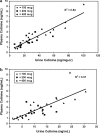Urine nicotine metabolite concentrations in relation to plasma cotinine during low-level nicotine exposure
- PMID: 19525206
- PMCID: PMC2734286
- DOI: 10.1093/ntr/ntp092
Urine nicotine metabolite concentrations in relation to plasma cotinine during low-level nicotine exposure
Abstract
Introduction: Plasma or saliva cotinine concentrations are used widely as biomarkers of secondhand smoke (SHS) exposure and have been associated with the risk of SHS-related disease. Concentrations of cotinine and other nicotine metabolites are considerably higher in urine than in plasma or saliva, making chemical analysis easier. In addition, urine is often more convenient to collect in some SHS exposure studies. The optimal use of nicotine metabolites in urine, singly or in combination, with or without correction for urine creatinine concentration, to estimate plasma cotinine concentration with low-level nicotine exposure has not been determined.
Methods: We dosed 36 nonsmokers with 100, 200, or 400 microg deuterium-labeled nicotine (simulating exposure to SHS) by mouth daily for 5 days and then measured plasma and urine cotinine and metabolites at various intervals over 24 hr.
Results: A plasma cotinine concentration of 1 ng/ml corresponds on average to a daily intake of 100 microg nicotine. Cotinine concentrations in urine averaged four to five times those in plasma. Correction of urine cotinine for creatinine concentration improved the correlation between urine and plasma cotinine. Measuring multiple cotinine metabolites in urine did not improve the correlation with plasma cotinine, compared with the use of urine cotinine alone.
Discussion: Measurement of urine cotinine corrected for creatinine concentration appears to be the best predictor of plasma cotinine.
Figures



References
-
- Benowitz N, Lessov-Schlaggar C, Swan G. Genetic influences in the variation in renal clearance of nicotine and cotinine. Clinical Pharmacology and Therapeutics. 2008;84:243–247. - PubMed
-
- Benowitz NL. Cotinine as a biomarker of environmental tobacco smoke exposure. Epidemiological Reviews. 1996;18:188–204. - PubMed
-
- Benowitz NL, Jacob P, III, Fong I. Gupta S. Nicotine metabolic profile in man: Comparison of cigarette smoking and transdermal nicotine. Journal of Pharmacology and Experimental Therapeutics. 1994;268:296–303. - PubMed
-
- Dempsey D, Tutka P, Jacob P, III, Allen F, Schoedel K, Tyndale RF, et al. Nicotine metabolite ratio as an index of cytochrome P450 2A6 metabolic activity. Clinical Pharmacology and Therapeutics. 2004;76:64–72. - PubMed
-
- Hecht SS, Carmella SG, Chen M, Dor Koch JF, Miller AT, Murphy SE, et al. Quantitation of urinary metabolites of a tobacco-specific lung carcinogen after smoking cessation. Cancer Research. 1999;59:590–596. - PubMed
Publication types
MeSH terms
Substances
Grants and funding
LinkOut - more resources
Full Text Sources
Molecular Biology Databases

